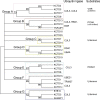The KCTD family of proteins: structure, function, disease relevance
- PMID: 24268103
- PMCID: PMC3882106
- DOI: 10.1186/2045-3701-3-45
The KCTD family of proteins: structure, function, disease relevance
Abstract
The family of potassium channel tetramerizationdomain (KCTD) proteins consists of 26 members with mostly unknown functions. The name of the protein family is due to the sequence similarity between the conserved N-terminal region of KCTD proteins and the tetramerization domain in some voltage-gated potassium channels. Dozens of publications suggest that KCTD proteins have roles in various biological processes and diseases. In this review, we summarize the character of Bric-a-brack,Tram-track, Broad complex(BTB) of KCTD proteins, their roles in the ubiquitination pathway, and the roles of KCTD mutants in diseases. Furthermore, we review potential downstream signaling pathways and discuss future studies that should be performed.
Figures
Similar articles
-
Structural complexity in the KCTD family of Cullin3-dependent E3 ubiquitin ligases.Biochem J. 2017 Nov 1;474(22):3747-3761. doi: 10.1042/BCJ20170527. Biochem J. 2017. PMID: 28963344 Free PMC article.
-
The emerging role of the KCTD proteins in cancer.Cell Commun Signal. 2021 May 17;19(1):56. doi: 10.1186/s12964-021-00737-8. Cell Commun Signal. 2021. PMID: 34001146 Free PMC article. Review.
-
The Structural Versatility of the BTB Domains of KCTD Proteins and Their Recognition of the GABAB Receptor.Biomolecules. 2019 Jul 31;9(8):323. doi: 10.3390/biom9080323. Biomolecules. 2019. PMID: 31370201 Free PMC article.
-
The BTB domains of the potassium channel tetramerization domain proteins prevalently assume pentameric states.FEBS Lett. 2016 Jun;590(11):1663-71. doi: 10.1002/1873-3468.12203. Epub 2016 May 24. FEBS Lett. 2016. PMID: 27152988
-
Emerging issues of connexin channels: biophysics fills the gap.Q Rev Biophys. 2001 Aug;34(3):325-472. doi: 10.1017/s0033583501003705. Q Rev Biophys. 2001. PMID: 11838236 Review.
Cited by
-
KCTD19 and its associated protein ZFP541 are independently essential for meiosis in male mice.PLoS Genet. 2021 May 7;17(5):e1009412. doi: 10.1371/journal.pgen.1009412. eCollection 2021 May. PLoS Genet. 2021. PMID: 33961623 Free PMC article.
-
Treatment of microglia with Anti-PrP monoclonal antibodies induces neuronal apoptosis in vitro.Heliyon. 2021 Dec 21;7(12):e08644. doi: 10.1016/j.heliyon.2021.e08644. eCollection 2021 Dec. Heliyon. 2021. PMID: 35005289 Free PMC article.
-
Genome-wide identification and expression analysis of the BTB domain-containing protein gene family in tomato.Genes Genomics. 2018 Jan;40(1):1-15. doi: 10.1007/s13258-017-0604-x. Epub 2017 Aug 14. Genes Genomics. 2018. PMID: 29892895
-
Improving Selection Detection with Population Branch Statistic on Admixed Populations.Genome Biol Evol. 2021 Apr 5;13(4):evab039. doi: 10.1093/gbe/evab039. Genome Biol Evol. 2021. PMID: 33638983 Free PMC article.
-
Calpain activity is negatively regulated by a KCTD7-Cullin-3 complex via non-degradative ubiquitination.Cell Discov. 2023 Mar 24;9(1):32. doi: 10.1038/s41421-023-00533-3. Cell Discov. 2023. PMID: 36964131 Free PMC article.
References
-
- Melnick A, Ahmad KF, Arai S, Polinger A, Ball H, Borden KL, Carlile GW, Prive GG, Licht JD. In-depth mutational analysis of the promyelocytic leukemia zinc finger BTB/POZ domain reveals motifs and residues required for biological and transcriptional functions. Mol Cell Biol. 2000;3(17):6550–6567. doi: 10.1128/MCB.20.17.6550-6567.2000. - DOI - PMC - PubMed
LinkOut - more resources
Full Text Sources
Other Literature Sources


